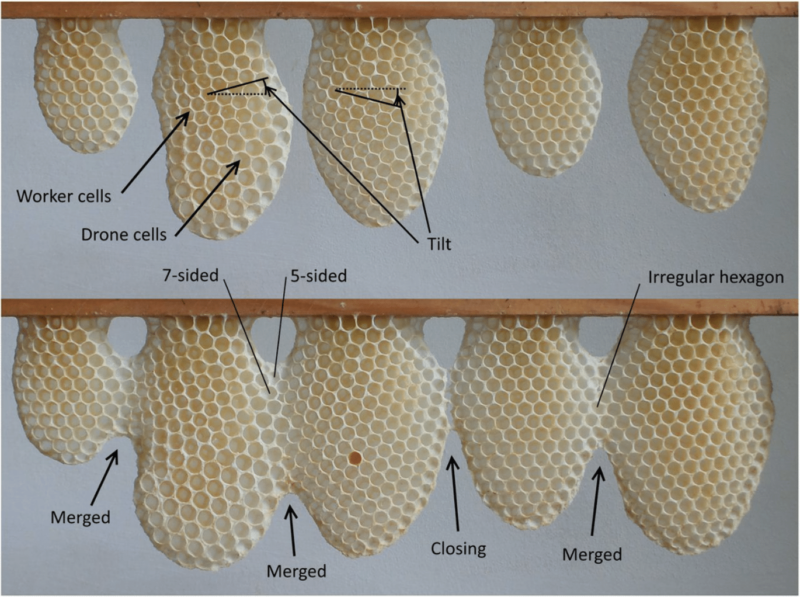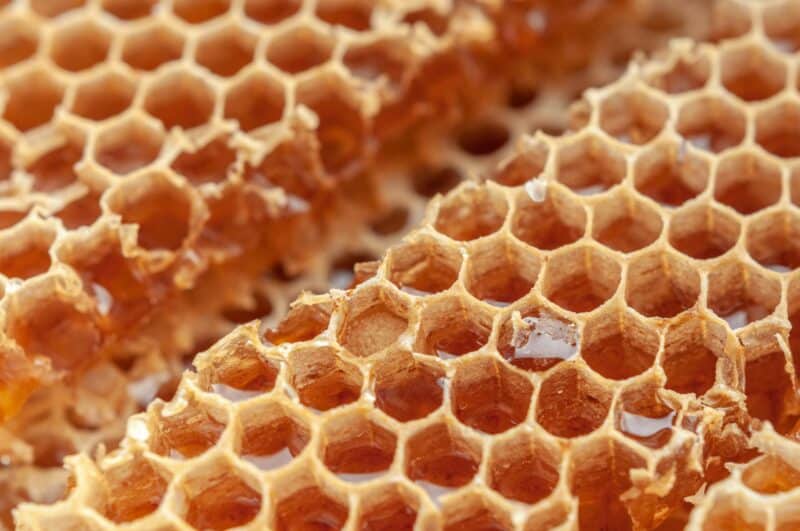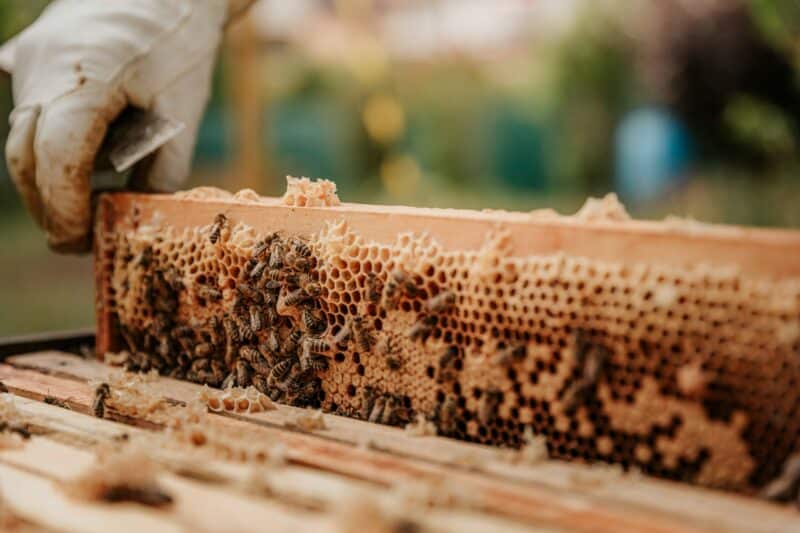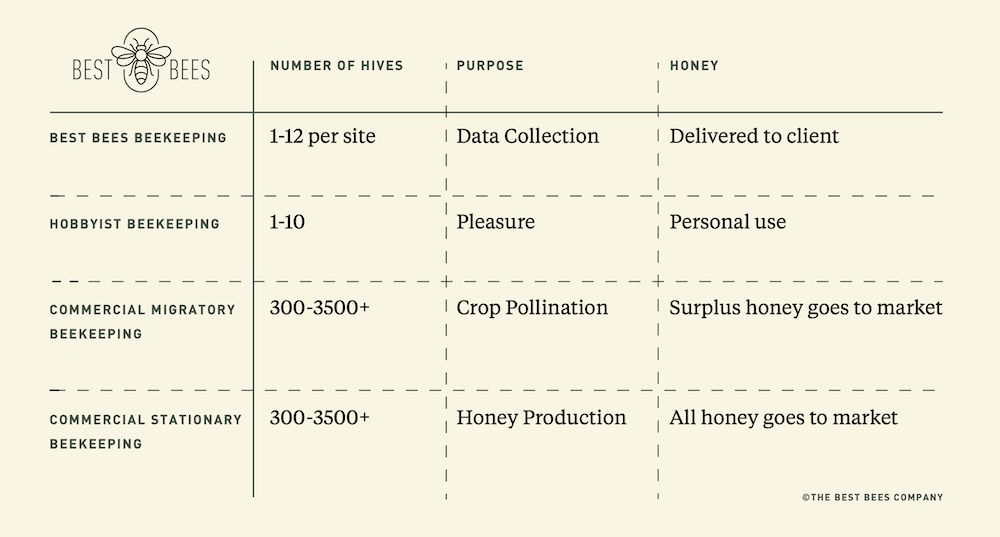Contents:
- What is Honeycomb, and What Is It Made Of?
- How Do Bees Make Honeycomb?
- Why Are Honeycomb Cells Hexagonal?
- The Architecture of Honeycomb
- Uses Of Honeycomb In The Hive
- Honeycomb and Beehive Health
- Is Honeycomb Edible? What Are the Benefits of Eating Honeycomb?
- How is Honeycomb Consumed?
- Does Eating Honeycomb Pose Any Health Risks?
- Other Uses of Honeycomb: Beeswax
- Where To Purchase Honeycomb
- FAQs
In 1780, Swiss naturalist Francois Huber revolutionized beehive design by introducing movable combs. Huber designed his hives as an aid to studying the history of the bee, rather than beekeeping. His hive would go on to inspire the Langstroth design that is a staple in beekeeping best practices.
But what takes place in those hives and how are honeycombs constructed?
Honeycombs are one of nature’s most amazing creations. Beautiful in the simplicity of their design, they’re one of the most efficient and flexible structures possible for brood raising and food storage. Since man first learned how to tend bees, we’ve found a myriad of uses for both honey and the combs bees store their honey and pollen in.
–– Interested to know how the bees are doing? Download our State of the Honey Bee Report now ––
What is Honeycomb, and What Is It Made Of?
Honeycomb is comprised of hollow, thin-walled hexagons about 5.5mm wide and 11mm deep, made from wax secreted from glands on worker bee abdomens. After the first cell in a comb is built, all the ensuing cells are built using one or more sides from flanking cells in their construction. The comb cells are attached to the hive frames, and as most hives have vertical hanging frames, the combs create vertical walls in which colonies raise new bees and store pollen and honey.
How Do Bees Make Honeycomb?
Comb construction requires the effort of many worker bees. Young worker bees eat honey and extrude wax through eight glands on their abdomens. As the wax builds up, it flakes off in clear, flat scales. They gather the wax scales and chew them to soften them and make them malleable, and use this processed wax to build combs, working from the hive frame out, attaching new sides to existing cells. It takes a hive between two weeks and two months to produce the honeycomb needed to store honey necessary to feed the colony through the winter.
The math behind honeycomb production is remarkable:
- Worker bees can produce about 8 scales of wax per 12-hour day.
- It takes 454,000 scales to make 1 lb. of beeswax.
- To make 1 lb. of wax, bees must consume 6-8 pounds of honey.
- To produce that much honey, they must gather 40+ pounds of nectar.
- To gather this much nectar, honeybees must visit 12-16 million flowers.
Why Are Honeycomb Cells Hexagonal?
While honeycomb cells are hexagonal in their final shape, bees start by building circular cells, but the warm, soft wax gets pulled into hexagons by the surface tension of the wax at the junction of three cell sides. Whether intentional or accidental, the hexagonal shape of honeycomb cells is a boon to bees: given how much time, energy and precious nutrients are required to build honeycomb, the hexagonal shape of the cells requires the least resources and produces the maximum output.
The hexagon is one of the strongest, flexible and most efficient shapes possible. This is why hexagonal structures are found throughout nature: many vascular plant systems use hexagonal tubes to transport water and nutrients from roots to leaves; animal bones are built from bundled hexagons to make them strong and light; wasps build their nests out of hexagonal paper cells.
The Architecture of Honeycomb
Research shows that the comb of honeybees is usually built downward, attached to the underside of a supporting structure such as a tree branch, a rocky outcrop or the upper surface of a cavity such as a hollow tree. Most of these natural surfaces are not smooth or flat.
In dealing with these challenges, bees are seen as architects. While one might assume that once the foundation is laid, bees could then switch to simple rules, building repetitive hexagons where the size is aligned with the worker’s body dimensions; however, the Proceedings of the National Academy of Sciences of the United States of America notes that bees must adapt the cell structures to merge those of differing size, orientation, and offset.

Uncommon Comb Shapes
An enormous diversity of cell shapes was found: Pentagons and heptagons were the most commonly observed non-hexagonal shapes, but there were also four, eight, and nine-sided cells.
The most common non-hexagonal cells (pentagons and heptagons) were often found in pairs or triplets, where a cell with a surplus face was found adjacent to another with fewer. It appears that bees, even when prevented from building a perfect specimen, will deviate from that ideal by as little as possible.
The article “Imperfect comb construction reveals the architectural abilities of honeybees” found that workers preemptively change their building behavior in constrained geometries to make space for larger hexagonal cells.
Researchers Vince Gallo and Lars Chittka suggest that “cells that are of an incorrect size or not hexagonal will seldom be used to raise brood but will be utilized for food storage and so are not wasted.”
Uses Of Honeycomb In The Hive
Honeycomb in the hive has three uses: as a nursery for new bees, as a short-term place to store pollen where it can quickly turn into “bee bread,”and as a storage for the hive’s honey reserves. In the wild, bee colonies place the brood cells in the center, with pollen combs around them, and honeycombs in the outer layer of cells.
In man-made hives, brood comb is usually placed in the lower frames in what are called “deep boxes.” The queen lays fertilized eggs there, which will become female worker bees, in standard sized cells, and unfertilized eggs, which will become male drones, into slightly larger drone cells. These tiny eggs hatch after three days into larvae. Worker bees feed the larvae royal jelly for another three days, and then switch to bee bread; around nine days, they cap the cells with a porous wax cover. After capping, the larvae turn into pupae and hatch into adult bees after 12 more days. Empty brood cells are quickly cleaned out by worker bees, readying them for new eggs.
Next to and below the brood comb is the comb where worker bees store pollen, mixing it with nectar, honey and saliva to form protein-rich bee bread. The addition of enzymes and probiotic bacteria in bee bread breaks down the pollen into something easily digestible by bees.
Beekeepers usually place comb where workers will store honey — the hive’s primary food resource — in honey supers (boxes) above the box containing the brood comb. Honey supers can contain 8-10 frames filled with honeycomb. Healthy hives may have 2-3 honey supers filled with honeycomb during the height of the season and may produce 30- 60 pounds of honey. Under ideal conditions, strong colonies may have honeycomb containing 100 pounds of honey or more!
Honeycomb and Beehive Health
“Wax, when first produced by worker bees, is a relatively pure substance,” reports Best Bees Bee Scientist Emily O’Neil. “But if poisons or pathogens are introduced to hive, they can permeate the wax. That’s why beekeepers need to sterilize or remove wax periodically.”
Over time, if bees have pollinated flowers exposed to pesticides and herbicides, these poisons can accumulate in the comb wax, posing a threat to bee health. To combat this, beekeepers rotate out frames periodically, cleaning them of wax before reusing. Freezing frames is another effective way of removing most pathogens from honeycomb.
If American or European Foulbrood, dangerous bacterial pathogens, infect a hive, the frames and the wax in them must be destroyed, as the bacteria can permeate the wax, infecting new colonies if reused.
Is Honeycomb Edible? What Are the Benefits of Eating Honeycomb?
Honeycomb is made of wax and honey, and it’s safe to eat; people have been eating it for thousands of years. Biting into a chunk of fresh honeycomb is the purest way to enjoy honey. The wax adds a delightfully chewy texture, and the sensory experience of the wax cells full of honey “exploding” in your mouth is unique to eating honeycomb. The health benefits of eating honeycomb revolve primarily around the honey it contains. Other than trace elements of vitamin A, the only nutritional value of the wax comb itself is as roughage.
The health benefits of honey have been detailed in another blog of ours, “Health Benefits of Honey and Beeswax.”
How is Honeycomb Consumed?
There are many ways to eat honeycomb. You can break it into small pieces and put it on cereal or salads, spread it on toast and muffins, stir small chunks of it into yogurt or softened ice cream, slice it thinly and use it to top pancakes or waffles, and serve cubes of it with cheese and charcuterie. And of course, you can eat it by itself — it’s delicious!
Does Eating Honeycomb Pose Any Health Risks?
There are few risks to eating honeycomb. As it contains honey, there is a slight chance it may be infected with C. botulinum spores, which are dangerous to pregnant women and children under 12 months. If you’re allergic to bee venom, you should avoid eating honeycomb, as you might have an allergic reaction. Eating mass quantities of it can occasionally cause gastrointestinal issues due to the wax, but you would not normally consume enough for that to be a major concern.
Other Uses for Honeycomb: Beeswax
When honeycomb capping is removed to harvest honey, the capping, once cleaned, is a great source of beeswax. The most prized wax is the first season wax, which is almost white in color. Beeswax has many, many uses. It can be used as a furniture polish, leather preservative or fire starter. It can act as a lubricant for sliding wooden drawers. You can seal canned foods with it. Beeswax can be made into candles, lip balm, body butter, or hand salves. Impregnated in fabric, it makes a great organic alternative to plastic wrap for preserving food. The possibilities go on and on!
Where To Purchase Honeycomb
Most health food stores carry honeycomb, and you can often find locally produced honeycomb sold by beekeepers at farmers’ markets. You can also buy it online from specialty honey producers or online retailers like Amazon, Walmart and Whole Foods.
FAQS
Q: Can You Eat Honeycomb?
A: Yes, honeycomb is safe for most everyone to eat.
Q: Is Honeycomb Nutritious?
A: The wax by itself has little nutritional value but is a good source of roughage. The honey in honeycombs is an excellent sweetener, containing antioxidants that can reduce inflammation, lower blood pressure, soothe sore throats and reduce coughing.
Q: Are There Any Health Risks in Eating Honeycomb?
A: Because of a very slight chance of C. Botulinum spore infection, pregnant women and children under 12 months might avoid eating it, as well as those with bee venom allergies. Eating a lot of honeycomb can, occasionally, cause bowel blockage, so eating it in large quantities is not recommended.
Q: Why Do Bees Build Honeycombs?
A: Wax comb cells are created by worker bees as chambers to raise new bees, to produce bee bread and to store honey reserves.
Q: What is Honeycomb Made Of?
A: Honeycomb is made of wax which is extruded from glands in worker bee abdomens. The wax is chewed and softened, and then formed into cells about 5.5mm wide and 11mm deep.










